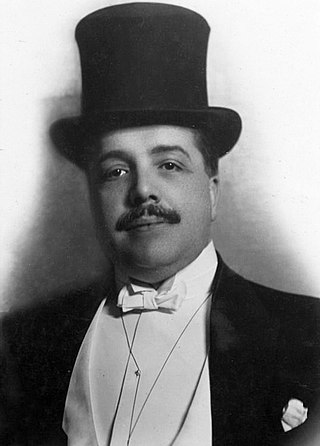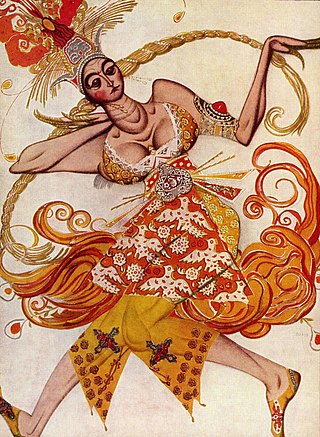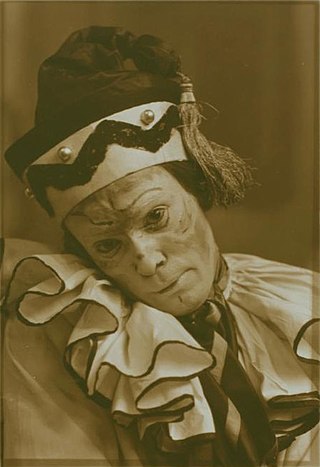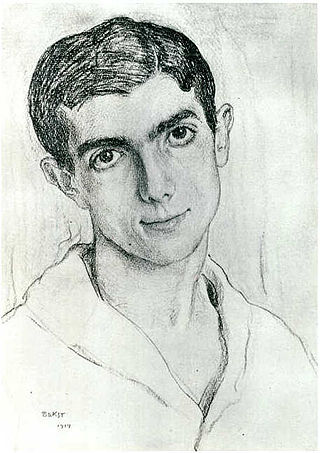
Sergei Sergeyevich Prokofiev was a Russian composer, pianist, and conductor who later worked in the Soviet Union. As the creator of acknowledged masterpieces across numerous music genres, he is regarded as one of the major composers of the 20th century. His works include such widely heard pieces as the March from The Love for Three Oranges, the suite Lieutenant Kijé, the ballet Romeo and Juliet—from which "Dance of the Knights" is taken—and Peter and the Wolf. Of the established forms and genres in which he worked, he created—excluding juvenilia—seven completed operas, seven symphonies, eight ballets, five piano concertos, two violin concertos, a cello concerto, a symphony-concerto for cello and orchestra, and nine completed piano sonatas.

Sergei Pavlovich Diaghilev, also known as Serge Diaghilev, was a Russian art critic, patron, ballet impresario and founder of the Ballets Russes, from which many famous dancers and choreographers would arise.

Roger Désormière was a French conductor. He was an enthusiastic champion of contemporary composers, but also conducted performances of early eighteenth century French music.
Ballet as a music form progressed from simply a complement to dance, to a concrete compositional form that often had as much value as the dance that went along with it. The dance form, originating in France during the 17th century, began as a theatrical dance. It was not until the 19th century that ballet gained status as a "classical" form. In ballet, the terms 'classical' and 'romantic' are chronologically reversed from musical usage. Thus, the 19th century Classical period in ballet coincided with the 19th century Romantic era in music. Ballet music composers from the 17th–20th centuries, including the likes of Jean-Baptiste Lully, Pyotr Ilyich Tchaikovsky, Igor Stravinsky, and Sergei Prokofiev, were predominantly in France and Russia. Yet with the increased international notoriety seen in Tchaikovsky's and Stravinsky's lifetime, ballet music composition and ballet in general spread across the western world.

Les Sylphides is a short, non-narrative ballet blanc to piano music by Frédéric Chopin, selected and orchestrated by Alexander Glazunov.

Pulcinella is a 21-section ballet by Igor Stravinsky with arias for soprano, tenor and bass vocal soloists, and two sung trios. It is based on the 18th-century play Quatre Polichinelles semblables, or Four similar Pulcinellas, revolving around a stock character from commedia dell'arte. The work premiered at the Paris Opera on 15 May 1920 under the baton of Ernest Ansermet. The central dancer, Léonide Massine, created both the libretto and the choreography, while Pablo Picasso designed the costumes and sets. The ballet was commissioned by Sergei Diaghilev, impresario of the Ballets Russes. A complete performance takes 35–40 minutes. Stravinsky revised the score in 1965.

The Firebird is a ballet and orchestral concert work by the Russian composer Igor Stravinsky. It was written for the 1910 Paris season of Sergei Diaghilev's Ballets Russes company; the original choreography was by Michel Fokine, who collaborated with Alexandre Benois and others on a scenario based on the Russian fairy tales of the Firebird and the blessing and curse it possesses for its owner. It was first performed at the Opéra de Paris on 25 June 1910 and was an immediate success, catapulting Stravinsky to international fame and leading to future Diaghilev–Stravinsky collaborations including Petrushka (1911) and The Rite of Spring (1913).

Petrushka is a ballet by Russian composer Igor Stravinsky. It was written for the 1911 Paris season of Sergei Diaghilev's Ballets Russes company; the original choreography was by Michel Fokine and stage designs and costumes by Alexandre Benois, who assisted Stravinsky with the libretto. The ballet premiered at the Théâtre du Châtelet on 13 June 1911 with Vaslav Nijinsky as Petrushka, Tamara Karsavina as the lead ballerina, Alexander Orlov as the Moor, and Enrico Cecchetti the charlatan.

Leonid Fyodorovich Myasin, better known in the West by the French transliteration as Léonide Massine, was a Russian choreographer and ballet dancer. Massine created the world's first symphonic ballet, Les Présages, and many others in the same vein. Besides his "symphonic ballets," Massine choreographed many other popular works during his long career, some of which were serious and dramatic, and others lighthearted and romantic. He created some of his most famous roles in his own comic works, among them the Can-Can Dancer in La Boutique fantasque (1919), the Hussar in Le Beau Danube (1924), and, perhaps best known of all, the Peruvian in Gaîté Parisienne (1938). Today his oeuvre is represented by his son Lorca Massine, who stages his works around the world.

Romeo and Juliet, Op. 64, is a ballet by Sergei Prokofiev based on William Shakespeare's play Romeo and Juliet. First composed in 1935, it was substantially revised for its Soviet premiere in early 1940. Prokofiev made from the ballet three orchestral suites and a suite for solo piano.

Serge Lifar was a Ukrainian dancer, choreographer, and one of the greatest male ballet dancers of the 20th century. Lifar was also a choreographer, director, writer, theoretician about dance, and collector.

The Scythian Suite, Op. 20 is an orchestral suite by Sergei Prokofiev written in 1915.

The Ballets Russes was an itinerant ballet company begun in Paris that performed between 1909 and 1929 throughout Europe and on tours to North and South America. The company never performed in Russia, where the Revolution disrupted society. After its initial Paris season, the company had no formal ties there.

Boris Evgenievich Kochno or Kokhno was a Russian poet, dancer, and librettist.
On the Dnieper, Op. 51, is a ballet in two scenes with prelude and epilogue by Sergei Prokofiev. Composed in 1931 as his fourth work in the genre, it resulted from a commission by the Ballet de l'Opéra National de Paris after the unexpected death in 1929 of Ballets Russes founder Sergei Diaghilev and after the success of The Prodigal Son. The premiere took place in 1932; a year later Prokofiev extracted an orchestral suite from the work, Op. 51 bis, using six of its twelve movements.

Trois mouvements de Petrouchka or Three Movements from Petrushka is an arrangement for piano of music from the ballet Petrushka by the composer Igor Stravinsky for the pianist Arthur Rubinstein.

The Nightingale is a short opera in three acts by Igor Stravinsky to a Russian-language libretto by him and Stepan Mitusov, based on a tale by Hans Christian Andersen: a nasty Chinese Emperor is reduced to tears and made kind by a small grey bird. It was completed on 28 March 1914 and premiered a few weeks later, on 26 May, by the Ballets Russes conducted by Pierre Monteux at the Palais Garnier in Paris. Publication, by the then Paris-based Éditions Russes de Musique, followed only in 1923 and caused the opera to become known by its French title of Le Rossignol and French descriptor of conte lyrique, or lyric tale, despite its being wholly Russian.
Chant du Rossignol, as it was published in 1921, is a poème symphonique by Igor Stravinsky adapted in 1917 from his 1914 opera The Nightingale.

Le pas d'acier, Op. 41, is a 1926 ballet in two scenes containing eleven dances composed by Sergei Prokofiev. Prokofiev also created a four-movement orchestral suite from the ballet.














